The “Extraordinary Measures” that the Government Uses in the Debt-Ceiling Farce to Delay a Default
The government can manipulate the gross national debt to keep it below the debt ceiling while issuing new debt. But not for long. Then the game is over.
By Wolf Richter for WOLF STREET.
Periodically, we get to watch our favorite farce, played out in Washington DC in front of a bedazzled world, a product of true creative genius that only American politicians could ever come up with: the Debt Ceiling Farce. This one is the Debt Ceiling Farce of 2023. We’re in the middle of it now, the point where the plot starts getting funny. The funny part is how close the government’s checkbook balance will go to zero before the farce is over.
On March 31, there were $194 billion in the government’s checkbook, the Treasury General Account (TGA) at the Federal Reserve Bank of New York, according to the Treasury Department this afternoon. During the two Debt Ceiling Farces of 2021, in October and in December, the balance dropped to $46 billion and $42 billion at the respective low points. During the Debt Ceiling Farce of 2017, the balance dropped to $39 billion. With the huge amounts of money that flow into and out of this account on a daily basis, that was pretty close. Congress then went ahead and lifted the debt ceiling, and the farce was over and everyone went home.
But the cash in the TGA account is only one factor. The other factor is something called the “extraordinary measures” – and we’ll get to them in a moment.
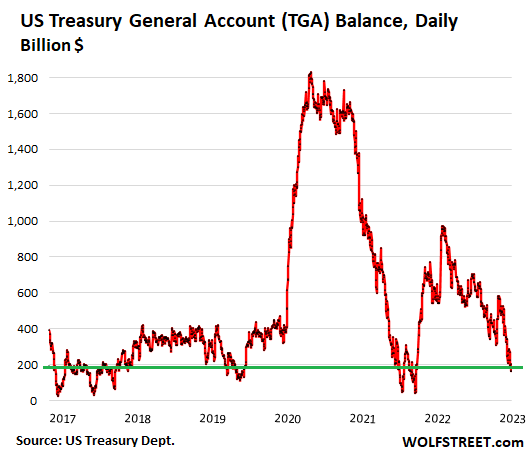
The ending of the farce is already known: Congress will agree on a deal at the last minute, as it has done around 79 times since 1960, and seven times over the past decade.
If they don’t agree on a deal, the US government will default on its obligations, hopefully starting with Congressional salaries, benefits, pension payments, and toilet paper.
But because lawmakers in Washington have stashed lots of their personal wealth in the markets, they’re sensitive to a US government default blowing up said wealth from one day to the next. And with their personal wealth at stake, they’ll get this worked out for sure.
It’s a farce because Congress already appropriated the funds to be spent, telling the Administration in detail via legislation how to spend those funds, and then Congress tells the Administration that it cannot borrow the funds that Congress told it to spend. This whole process is accompanied by all kinds of hilarious rhetoric for the entertainment of us all.
On January 19, the US gross national debt hit the debt ceiling, set by Congress at $31.4 trillion. The Administration now cannot increase the gross national debt. And it has remained flat since then. But note what always happens the day after Congress lifts the debt ceiling: the debt spikes! (We’ll get to the circled event in a moment under “Extraordinary measures at the end of the fiscal year?”):
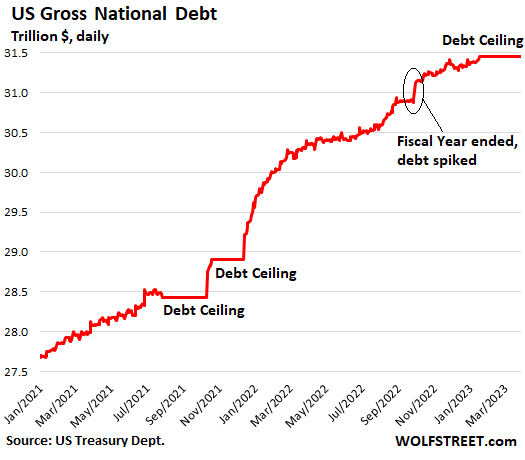
For example, after the last two debt-ceiling farces ended in October 2021 and in December 2021:
On October 13, 2021, Congress lifted the debt ceiling. The next day, the gross national debt spiked by $300 billion! Over the next seven business days, the debt spiked by $480 billion!
On December 15, 2021, Congress lifted the debt ceiling. The next day, the gross national debt spiked by $298 billion in just one day. In total, over the 11 following business days, the debt spiked by $709 billion!
From October 13, 2021, through December 31, 2021, over those 11 weeks, the gross national debt spiked by $1.19 trillion, LOL.
When the Debt Ceiling Farce of 2023 is over, you will see another one of my articles, with the headline, “US National Debt Spikes by $500 billion in One Day,” or whatever.
But the debt doesn’t spike by a gazillion dollars in just one day because suddenly the government sold a gazillion Treasury securities. Far from it. Treasury auctions are planned in advance and continue throughout the debt ceiling farce.
What triggered those spikes of the debt in one day is the system of “extraordinary measures.” And it has always been this way. Here are the seven debt-ceiling farces over the past decade. You can tell that the one thing the debt ceiling never actually does is slow down the growth of the debt.
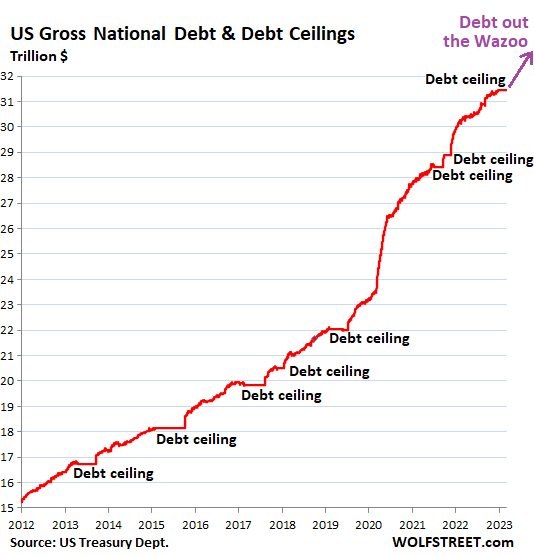
The “extraordinary measures.”
All these debt ceiling farces do is force every Administration to jump through some hoops, called “extraordinary measures” – and Congress is fully on board and is informed about them, which is also part of the farce.
On January 19, 2023, Secretary of the Treasury Janet Yellen – as her predecessors had to do also – sent a letter to Congressional Leadership, notifying them that the debt ceiling had been reached, and that the Administration would begin using “extraordinary measures” going forward.
These “extraordinary measures” center around various federal government trust funds and other federal accounts, mostly government pension systems (military retirement, civil service retirement) and the Social Security and disability trust funds, plus the Medicare account.
In her letter to Congress, Yellen named two of these funds: the Civil Service Retirement and Disability Fund and the Postal Service Retiree Health Benefits Fund. And she wrote that “by law,” the funds “will be made whole once the debt limit is increased or suspended. Federal retirees and employees will be unaffected by these actions.”
Normally, these trust funds invest the cash coming from their contributors into special non-marketable Treasury securities (often called “Intragovernmental Holdings”).
Those non-marketable Treasury securities were at $6.89 trillion at the time Yellen sent the letter to Congress. They have since then dropped by $93 billion to $6.76 trillion currently. They dropped because the government didn’t issue them to the full extent normally needed. This pushes down the gross national debt.
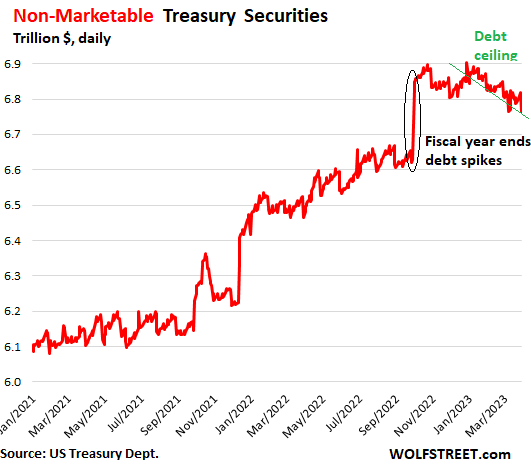
“Extraordinary measures” at the end of the fiscal year?
You have noted the “circled event” in the chart above. So here we go. Non-marketable Treasury securities can be sold essentially with a click of the mouse to funds that hold trillions of dollars and have lots of cash to invest. Since the issuer of these securities and the buyers of these securities are within the same government, the timing of issuance can be played with up to certain limits.
I mean, look, I’m not going to say that Yellen did anything funny to make the debt look better at the end of its fiscal year. I mean, she used to run the Fed and supervise the banks etc. etc., and she’d never do anything like that. But look at the second chart above, at the circled event, at what happened the day after the last fiscal year ended.
On September 30, 2022, the end of the fiscal year, these non-marketable securities amounted to $6.629 trillion. This put the overall gross national debt at $30.92 trillion – just under the nasty $31-trillion bar.
And the next working day, October 3, these nonmarketable securities jumped by $200 billion exactly in one day, and the gross national debt leapt with ease over the $31-trillion bar, to $31.12 trillion. And then they jumped by another $30 billion over the next two days.
Meanwhile, marketable Treasury securities continue to balloon.
Since January 19, when Yellen sent Congress the debt-ceiling letter, the amount of regular Treasury securities outstanding – those that everyone can buy and trade – increased by $96 billion to $24.69 trillion — compared to the $93 billion drop in non-marketable securities, and so the total debt remained roughly flat at the debt ceiling of $31.4 billion.
Treasury auctions are still taking place, the government is rolling over maturing debt at these auctions, and it’s also issuing new debt. Hence, the net increase in marketable Treasury securities since the debt ceiling was hit:
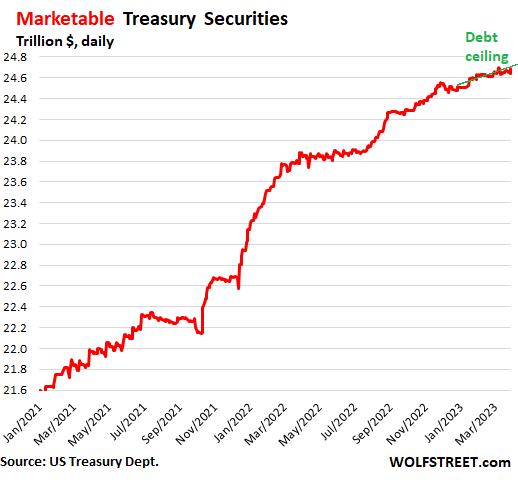
Combined, non-marketable Treasury securities and marketable Treasury securities make up the $31.4 trillion in the gross national debt. By lowering the amount of non-marketable securities, the government can keep adding to its marketable Treasury securities outstanding, and thereby add to its actual debt, and raise more cash.
But there are real-world limits to this game of “extraordinary measures,” when this game can no longer be played, and if the debt ceiling will then not be raised, the US government will start defaulting on some of its obligations – starting hopefully with Congressional salaries and toilet paper.
Enjoy reading WOLF STREET and want to support it? You can donate. I appreciate it immensely. Click on the beer and iced-tea mug to find out how:

Would you like to be notified via email when WOLF STREET publishes a new article? Sign up here.
![]()
[ad_2]
Source link


